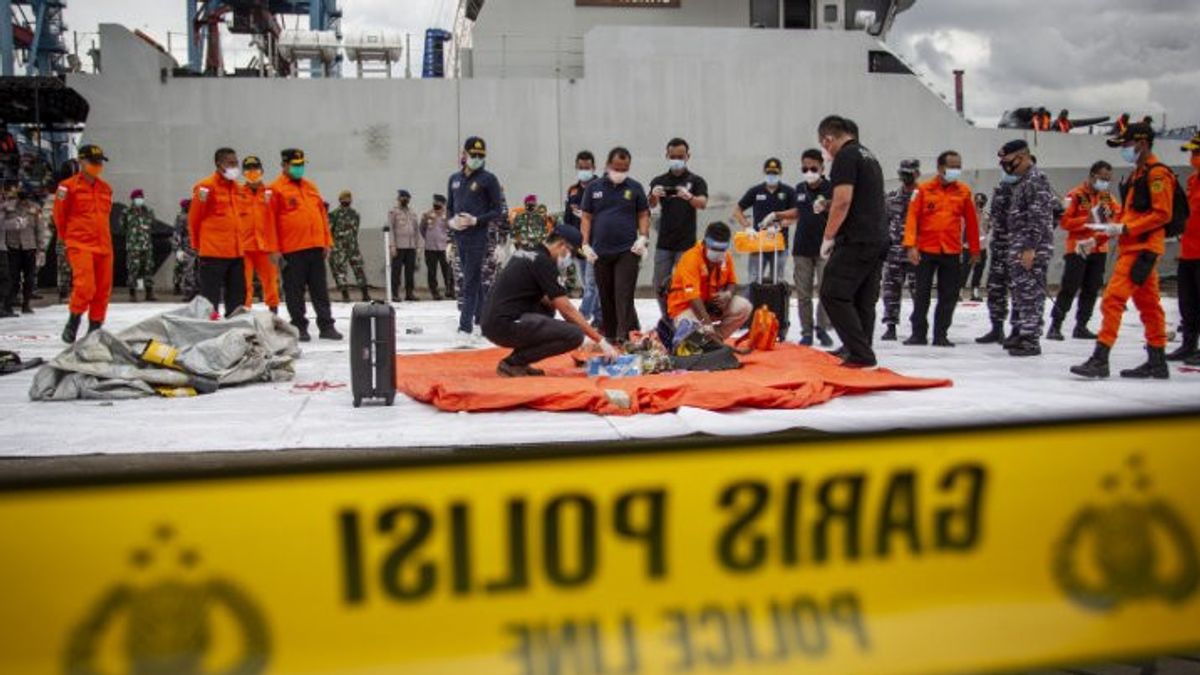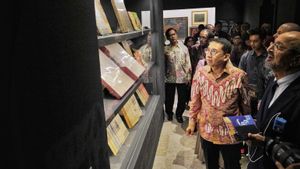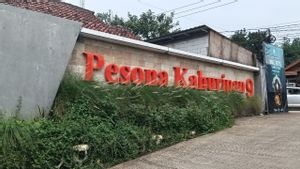JAKARTA - After flying for four minutes from Soekarno-Hatta Airport, Cengkareng to Supadio Airport, Pontianak, the Sriwijaya Air SJ-182 plane lost contact and was later declared to have crashed in the waters of the Thousand Islands to be precise around Lancang Island and Male Island.
After a search process carried out by the Search and Rescue (SAR) Team from various elements, a number of body parts or body parts of this passenger plane could be found and now the National Police's Disaster Victim Organization (DVI) Team has successfully identified 17 people.
Taking off from Soekarno-Hatta Airport, Cengkareng on Saturday, January 9, at 2:36 p.m. the plane piloted by Captain Afwan suddenly disappeared from the radar after making a maneuver to the northwest or in a direction that was not ordered by the Air Trafic Controller (ATC). Furthermore, the plane carrying 50 passengers consisting of 43 adults, 7 children and 3 babies was declared downed by the authorities.
The SAR team moved quickly after the crash point was found. At sea, in addition to trying to find black contacts containing the cockpit voice recorder (CVR) and flight data recorder (FDR) to analyze the causes of the crash, the team also tried to find the bodies of passengers and other items.
While on the ground, the Police DVI Team attempted to collect data from the families of the passengers. One way is to open an Antemortem Post in Pontianak and at the Kramat Jati Police Hospital, so that the family can submit the data needed for identification purposes including DNA samples.
Body bags containing passenger body parts began arriving at the National Police Hospital for identification. Furthermore, Monday, January 11, the DVI team consisting of dozens of experts ranging from forensic experts to anthropologists managed to identify one of the passengers on behalf of Okky Bisma who was the steward of the unlucky plane.
Head of the National Police Inafis Center Brig. Gen. Hudi Suryanto said that Okky could be identified by matching fingerprints from antemortem and postmortem data. In addition, this matching is also assisted by data from the recording of an electronic identity card (e-KTP) which is used in a special device for reading fingerprints.
"When fingerprints are linked with a special tool, they are directly connected to the database in the dukcapil and bring up (names, red) candidates," he explained to reporters at the Police Hospital.
Okky's name contained in the data that emerged from the fingerprint-based device was then matched with the manifest received by the DVI Team and the result was that he was registered as passenger number four. The matching results are identical and cannot be wrong because 12 points of similarity were found and this cannot be wrong.
After the name Okky Bisma became the first passenger identified, the team also succeeded in identifying 16 other people the following day.
On Tuesday, January 12, three people were identified, namely Fadly Satrianto, who was an extra crew or copilot from NAM Air who would take the plane from Supadio Airport, Pontianak; Asy Habul Yamin; and Khasanah. Next, on Wednesday, January 13, two passengers were identified, namely Agus Minarni and Indah Halimah Putri.
Furthermore, on Thursday, January 14th, there were six people who were identified as Ricko; Ihsan Adhlan Hakim; Supianto; Pipit Piyono; Mia Tresetyani who is a flight attendant; and Yohanes Suhardi. Then on Friday, January 15, the DVI Team managed to identify Toni Ismail, Dinda Amelia, Isti Yudha Prastika who were an extra crew and a flight attendant, Putri Wahyuni, and Rahmawati.
From a total of 17 passengers who were identified, only five were identified through DNA. They are Ricko, Pipit Priyono, Rahmawati, Putri Wahyuni, and Dinda Amelia.
How is the identification process using DNA carried out?Head of the DNA Laboratory of the National Police Health Center, Kombes Ratna, said that the process of identifying a body through DNA has to go through a long process. He emphasized that this process is not as easy as checking health or cholesterol levels from blood samples that can get the results as quickly as possible.
"So first, after we get the sample, we have to look at the sample first. Can we use it or which one is likely the DNA will appear after it is extracted and there is a further process," said Ratna to reporters.
The state of the body parts or body parts also has an effect. Since body parts are found submerged in water, sterilization must be carried out.
"The body part is submerged in water. This is a challenge for us to be more careful and careful, because the DNA must be sterile, the DNA examination must be sterile," he said.
So, before carrying out the identification of body parts, it is necessary to sterilize them first so that they are not contaminated with cells from other parts found in one location.
This whole process, said Ratna, should not be overlooked and carried out carelessly. Because, if there is one process that is missed, the body part of the passenger will not be identified.
"If in the post mortem, maybe it has been separated at the scene of the crime, maybe it has been separated, but in cell, cell, it also has to be separated again. This is what requires these stages, and these stages cannot be skipped because if they are passed later the results will not appear," he said.
This is very different from fingerprint identification. He said, identification with fingerprints is easier because there is already a database from the Dukcapil of the Ministry of Home Affairs.
Despite facing certain difficulties, however, the National Police, through the DVI Team, will certainly continue to identify the passengers of this plane so that they can be returned to their families.
"The team will work until the body part is gone," said Karo Penmas, Police Public Relations Division, Brigadier General Rusdi Hartono.
This identification will continue so that the passenger's family will have certainty. "We will work optimally and provide assurance to the families of the victims," he said.
This statement was made not only once. After claiming to have identified 17 passengers per day, Rusdi also repeated the same statement and hoped that all passengers could be identified because his party had managed to collect 62 DNA samples from the families of the passengers.
"DNA samples for 62 victims are complete. So there are 140 DNA samples for all the victims," said Rusdi.
"Hopefully in the future we can re-identify it and of course this is a big hope for the victim's family to be able to bring the body home," he concluded.
The English, Chinese, Japanese, Arabic, and French versions are automatically generated by the AI. So there may still be inaccuracies in translating, please always see Indonesian as our main language. (system supported by DigitalSiber.id)








